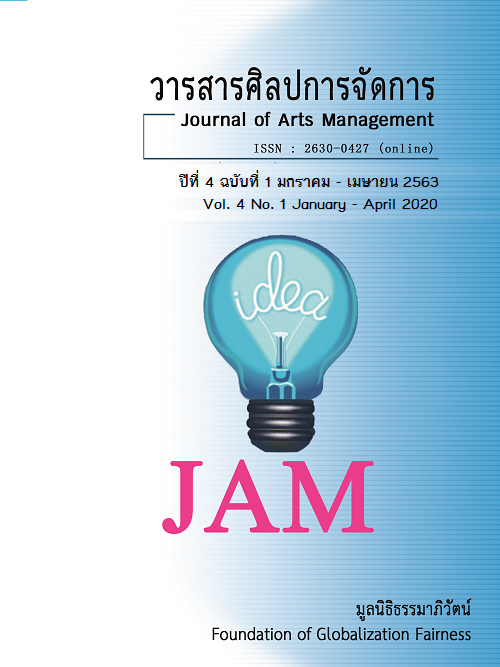The Acceptation of Cloud System Effects to Be Decision Making to Use Accounting Information System in Business for Accountants
Main Article Content
Abstract
The objectives of this research were 1) to study the acceptation of cloud system effects to be decision making to use accounting information system in business for accountants and 2) to study the organizational environment that effects to be decision making to use accounting information system in business for accountants. The sample group in this research were accountants to work in business enterprises 400 establishments throughout Bangkok by using of questionnaires as the data collection tool. The statistics of data analysis in process comprised of descriptive statistics which consists of frequency, percentage, mean and standard deviation as well as inferential statistics which used the multiple linear regression analysis.
The results were found that 1) the acceptation of cloud system which consists of the benefits of knowledge gained, the ease of use and technology awareness were the main factors effects to be decision making to use accounting information system in business for accountants, with a statistical significant level of 0.05. 2) the organization's environment which consisted of the organization’s internal and external factors for the business enterprises from the accountants’ perspective with a statistical significant level of 0.05.
Article Details
Views and opinions appearing in articles in the Journal of Arts of Management It is the responsibility of the author of the article. and does not constitute the view and responsibility of the editorial team I agree that the article is copyright of the Arts and Management Journal.
References
กรมพัฒนาธุรกิจการค้า. (2561). จำนวนสถานประกอบการภาคธุรกิจ สถานะของนิติบุคล ณ วันที่ 31 ธันวาคม 2560. สืบค้นจาก http://www.dbd.go.th/news_view.php?nid=469407271
กัลยา วานิชย์บัญชา. (2558). การใช้ SPSS for Windows ในการวิเคราะห์ข้อมูล. (พิมพ์ครั้งที่ 15). กรุงเทพฯ: จุฬาลงกรณ์มหาวิทยาลัย.
ชาญชัย อรรคผาติ. (2557). ปัจจัยที่ส่งผลต่อทัศนคติในการยอมรับในเทคโนโลยีคลาว์ดคอมพิวติ้ง เพื่อประยุกต์ใช้ในการให้บริการระบบบัญชีออนไลน์ สำหรับวิสาหกิจขนาดกลางและขนาดย่อมในมุมมองของผู้ทำบัญชี. (วิทยานิพนธ์ปริญญามหาบัณฑิต). มหาวิทยาลัยธุรกิจบัณฑิต. กรุงเทพฯ
เยาวนุช ใจรักสงฆ์. (2561). ปัจจัยที่ผลต่อการยอมรับและการใช้ระบบบัญชีออนไลน์แบบคลาวด์ของวิสาหกิจขนาดกลางและขนาดย่อมในประเทศไทย. (วิทยานิพนธ์ปริญญามหาบัณฑิต). มหาวิทยาลัยขอนแก่น. ขอนแก่น
Davis, F.D. (1989).Perceived Usefulness, Perceived Ease of Use, and User Acceptance of Information Technology. MIS Quarterly, 13(3), 319-40.
Ellitan, L. (2002). Factors Influencing an Access of Technology Adoption: A Case Study of Indonesian Manufacturing. (Master Thesis), Universitas Kristen Petra, Surabaya, Indonesia.
Hair, J. F. Jr, Black, W.C., Babin, B. J. Anderson, R.E., & Tatham, R. L. (2006). Multivariate Data Analysis (6th ed.) Upper Saddle River, NJ: Prentice-Hall.
Johnston S. (2009). The Cloud and Cloud Computing consensus definition. Retrieved from
https://samj.net/2008/07/24/the-cloud-and-cloud-computing-consensus-definition/
Marius MARIAN. (2012). Guidelines for Increasing the Adoption of Cloud Computing within SMEs,
CLOUD COMPUTING 2012: The Third International Conference on Cloud Computing, GRIDs, and Virtualization, ISBN: 978-1-61208-216-5.
Morgan Lorraine Lero and Conboy Kieran. (2013). Factors Affecting on the Adoption of Cloud
Computing: An Exploratory Study, Proceedings of the 21st European Conferences on
Information System.
Nutanix, (2019). Enterprise Cloud Index 2019 Edition Application Requirements to Drive Hybrid Cloud Growth. Access from https://www.nutanix.com/enterprise-cloud-index
Pedhazur, E. J. (1997). Multiple Regression in Behavioral Research: Explanation and Prediction. (3rd ed). Fort Worth: Harcourt Brace College Publishers.
Faith, S. (2010). Cloud Computing: Strategies for Cloud Computing Adoption, Masters Dissertation. Dublin, Dublin Institute of Technology.
Stanislav, N. (2014). Exploring the factors influencing the adoption of Cloud computing and the challenges faced by the business. The ACES Journal of Undergraduate Research.
Studenmund A.H. (2011). Using Econometrics A Practical Guide. (6th ed.). Bangkok Pearson Education Indochina.
Vaquero L.M., Luis Rodero-Merino, Juan Caceres & Maik Lindner. (2009). A break in the clouds: towards a cloud definition. SIGCOMM Comput. Commun. Rev.0146-4833. 39, 50-55.
Yamane, T. (1983). Statistics: An Introduction Analysis. Tokyo: Hapa International Edition.


